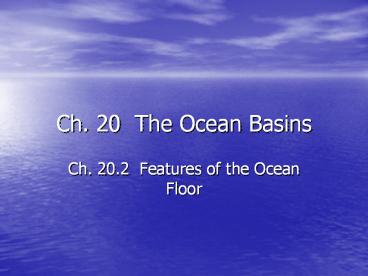Ch. 20 The Ocean Basins - PowerPoint PPT Presentation
1 / 16
Title:
Ch. 20 The Ocean Basins
Description:
Ch. 20 The Ocean Basins Ch. 20.2 Features of the Ocean Floor Two Major Divisions of the Ocean Floor 1. Continental Margins shallower portions made up of continental ... – PowerPoint PPT presentation
Number of Views:173
Avg rating:3.0/5.0
Title: Ch. 20 The Ocean Basins
1
Ch. 20 The Ocean Basins
- Ch. 20.2 Features of the Ocean Floor
2
Two Major Divisions of the Ocean Floor
- 1. Continental Marginsshallower portions made
up of continental crust and a thick wedge of
sediment. - 2. Deep Ocean Basinmade up of oceanic crust and
a thin sediment layer.
3
Continental Margins
- The line that divides continental crust from
oceanic crust is almost always offshore. - Continental Shelfpart of a continents edge
covered by ocean water. Slopes gently away from
the shore. - Average depth of about 60 meters.
- Width of the continental shelf varies, but
averages about 70 km wide.
4
- Affected by changes in sea level.
- During ice ages, sea levels fall, and more
continental shelf is exposed to weathering and
erosion.
5
Continental Slope
- Steeper slope at edge of the continental shelf.
- Continental slopes base is the boundary between
the continental and oceanic crust. - Ocean depth rapidly increases along the
continental slope.
6
(No Transcript)
7
- May be cut by deep V-shaped valleys called
submarine canyons, which could have been caused
by river flows or turbidity currents (underwater
sediment landslides). - Along the base of the continental slope is a
raised wedge of sediments called the continental
rise.
8
- stop
9
Deep Ocean Basins
- Contain higher mountains and flatter plains than
any found on the continents! - Trenchesdeepest feature of the earths surface.
Mariana Trench is over 11,000 meters deep.
Associated with subduction zones and all of their
features, such as earthquakes, volcanic island
arcs, and volcanic mountain ranges.
10
Abyssal Plains
- Vast flat areas in the deep ocean basins where
depth is often greater than 4 km. - Flattest regions on earth, covering about half of
the deep ocean basins. - Covered with sedimentthin in the Pacific, but
much thicker in the Atlantic Ocean, which is not
bordered by trenches.
11
(No Transcript)
12
Mid-Ocean Ridges
- Underwater mountain ranges that run along all
ocean floors. - Result from divergent plate boundaries.
- A rift valley runs along the crest (top) of the
ridges. - New magma rises up through the rift.
13
- Warm, new crust is less dense than cold, older
crust away from the ridge, so the colder, denser
rock sinks, and elevation decreases as you move
away from the ridge. - Fracture zones result from different parts of the
ridge separating at different ratesthey are
faults that run perpendicular to the ridge.
14
(No Transcript)
15
Seamounts
- Submerged volcanic mountains at least 1000 m
high. - Abyssal hillssubmerged volcanic mountains less
than 1000 m. - Both are usually associated with hotspots.
- Seamounts that rise above the surface become
volcanic islands. - Guyots (GEE-oze)sunken volcanic islands that
have had their tops eroded flat by wave action.
16
(No Transcript)































